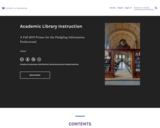
This Pressbook is written to help librarians create and guide instruction in the academic library realm.
- Subject:
- Information Science
- Material Type:
- Textbook
- Provider:
- University of Washington Libraries
- Author:
- rebwn
- Date Added:
- 04/05/2021

This Pressbook is written to help librarians create and guide instruction in the academic library realm.

This resource is the manual for "Allele A1" Software. AlleleA1 simulates evolution at a single locus in an ideal population of imaginary organisms. The user enters values for parameters controlling selection, mutation, migration, genetic drift, and inbreeding. As the simulation runs, the software plots a graph showing the frequency of allele A1 over time. The resource, "Allele A1 Manual (pdf)" within "Lesson 03 Population Genetics and the Evolution of Resistance - Elaboration" is a part of Unit 06 Population Genetics and the Evolution of Resistance included in Agriscience & Biotechnology, Ag Bio - Course 2.

This zine is a collection of biographies and portraits of badass womxn in the Pacific Northwest. Undergraduate students collaborated to create this resource that fuses multilingual poetry, art, and writing to celebrate and honor some of the strongest people you might not have heard of.
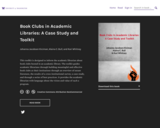
This toolkit is designed to inform the academic librarian about book clubs hosted in an academic library. The toolkit guides academic librarians through building meaningful and effective book clubs at their institutions through an overview of extant literature, the results of a cross-institutional survey, a case-study, and through a series of best practices. It provides the academic librarian with language about the vision and value of such a program.
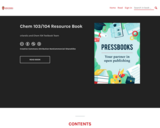
Beginning in 2016, Chem 103/104 transitioned to a student-focused, active-learning philosophy. Students progress to mastery of the course learning objectives by engaging in frequent, structured activities. These activities may be performed individually (pre-class activities), in small groups (discussion, lab, and some whole-class activities), or with an entire lecture section with answers submitted via Top Hat student response system. A Module comprises a set of related content that generally approximates a traditional textbook chapter. Each module is broken into Quanta with distinctive pre-class (brief introduction to content followed by assessment quizzes) and whole-class (higher level content development, “ConcepTest” assessments of individual learning, and small group-oriented activities) activities. UW-Madison Chemistry 103/104 Resource Book supports these activities by providing learning objectives, in-depth descriptions of the content, many worked examples, practice problems, and a glossary for each quantum.
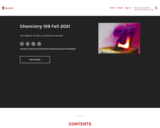
This course has many features designed to help you learn chemistry. It is organized into units, each of which ends with an exam. Within each unit there is a weekly schedule. Within each week there are whole-class meetings where lecture and group work will be done, a discussion section for group work, and a laboratory session. Before each whole-class meeting there is a pre-class activity that will make sure you have the background needed for the class session. There are post-exam activities that will ask you to reflect on your study habits and what you have learned. There will be activities during each class period, and there is homework each week. Laboratory work enables you to learn techniques and apply what you have learned in class. All course information is available in a course management system called Canvas. An online system called Piazza (link provided in Canvas) allows you to post questions anytime and get responses quickly. Your course instructors will have office hours during which difficult materials can be discussed and explained: make use of them!
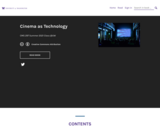
Even as cinema is an aesthetic experience, a commercial institution, and a social practice – it is first and foremost a mode of using machines. This course surveyed the history of cinema as technology from its origins within the machines of 19th century visual culture to its digital manifestations in the present. The moving image originally came into being from experiments measuring motion, before film technicians around the world (most prominently in Hollywood) created a language for narrating stories through techniques and tricks of camera, editing and eventually, sound. The post-World War II new cinemas and revolution in documentary would not have been possible without the miniaturization of cameras, better film stock, and ease of sound recording. As cinema moved from film to video, and now to digital, what has not changed is the urge to experiment with the means of production, that is the material equipment of movie making. In this course, we watched and read about movies where the story content was not so much our focus, but the technologies that allow us to experience the magic of cinema. We started the course with discussing the multiple origins of cinema, followed by watching and learning about early cinema. Next, we moved on to Classical Hollywood Cinema, where we discussed camerawork, lighting, amateur film, and the coming of sound and color. Discussions on documentary, television, and home video were also on our list. The course ended with materials central to contemporary times like videogames, Netflix, virtual reality and artificial intelligence. In wrapping up the course, students were asked to write short essays on any topic of their choice, related to media technology. Here they are, arranged alphabetically as per the last names of the authors. Enjoy.
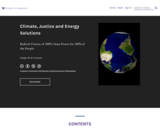
Science communicators have parroted fake climate “solutions” straight from the mouths of corporate public relation firms, even those that are clearly unjust and against the will of the people. They’ve ignored messages from communities who are suffering most from pollution. Although often inadvertently, scientists, with their disproportionately large megaphones, have helped to uphold existing power structures. This free textbook is an attempt to remedy this hole in science communication, providing a framework for learning about the science of the climate crisis for those who don’t accept the status quo. Climate, Justice and Energy Solutions is for visionaries, dreamers, utopian thinkers, and social justice advocates. It’s for those who can imagine not just surviving in a world without fossil fuels, but truly flourishing. The hope is that activists in a wide range of fields can use this text to help bolster their knowledge of science-based climate action when they’re building the next wave of social movements, renewable power networks, and regenerative communities.
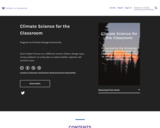
Modules, games and labs focused on teaching climate change. Developed by graduate students and faculty associated with the UW Program on Climate Change, a cross departmental collaboration to research, teach and communicate climate science. Updated regularly.
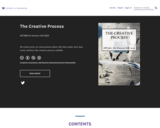
20 visual artists in conversation about why they make, how they work, and how the creative process unfolds.

The contents of this online book were created by Prof. Rick Bonus and his students as a final project for a course on “Critical Filipinx American Histories” in the Fall quarter of 2019 at the University of Washington, Seattle campus. In collaboration with the UW Libraries, the UW Burke Museum, and the UW Department of American Ethnic Studies, this book explores and reflects on the relationships between Filipinx American histories and selected artifacts at the Burke Museum. It is a class project that was made possible by the Allen Open Textbook Grant.
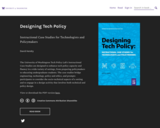
The Design Case Studies offer instructors with a starting point for introducing students to the design of technology and policy. Students work with value sensitive design methods to develop tech policy solutions.View or download the PDF version here.

English 100 is designed to emphasize writing as a process of discovery and to give you many opportunities for the kind of practice that builds self-knowledge. Some of the readings you’ll do for this course will provide examples of effective writing. Others will focus on “writing practices” that provide ideas for approaching any writing project, though especially writing in this course. Invention, drafting, research, revision, and editing can be considered stages of the writing process, but this process is rarely linear. Most writers move between these stages as they discover new ideas and information, come up with fresh ways to say things, and adjust their lines of reasoning. You’ll move through this recursive process several times during the semester as you explore and develop ideas; sharpen and clarify descriptions, narratives, and arguments; and, finally, present your work in clear, organized, and effective ways.

Jacob Lawrence (1917-2000) is widely recognized as one of the most important American artists of the 20th century. He is best known for epic multi-panel narratives like the Migration Series (1940-1941) and Struggle: from the History of the American People (1954-56), which he created as a young artist living and working in in New York City. The second half of Lawrence’s career, which he spent in Seattle as a Professor of Art at the University of Washington, has received far less attention. The essays in this volume, researched and written by the participants in the Spring 2021 art history seminar “Art and Seattle: Jacob Lawrence” at the University of Washington School of Art + Art History + Design, fill in this gap. In so doing, we take our lead from the artist’s own framing of the Seattle period as a critical stage in his artistic development, in which conceptual and formal concerns explored across his long career converged and became more of the sum of their parts.
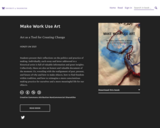
Students present their reflections on the politics and practice of making. Individually, each essay and letter addressed to a historical artist is full of valuable information and great insights. Collectively, these are also an honest and valuable document of the moment: Us, wrestling with the realignment of past, present, and future of why and how to make objects, how to find freedom within tradition, and how to reimagine a more conscientious making practice for ourselves and a more meaningful life for our objects.
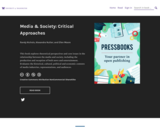
This book explores theoretical perspectives and core issues in the relationship between the media and society, including the production and reception of both news and entertainment. Evaluates the historical, cultural, political and economic contexts of media industries, representations, and audiences.
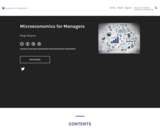
Principles of Economics is adapted from a work produced by a publisher who has requested that they and the original author not receive attribution. This adapted edition is produced by Margo Bergman at the University of Washington Tacoma.
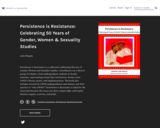
Persistence is Resistance is a collection celebrating 50 years of Gender, Women and Sexuality Studies. Contributors are a diverse group of scholars, from undergraduate students to faculty emeritus, representing twenty-two institutions. Essays cover GWSS’s history, praxis, and implementation. The book also includes artwork by GWSS undergraduates and alumni, and their answers to “why GWSS?” Persistence is Resistance is ideal for the classroom because the essays are short, jargon light, and inspire feminist inquiry, activism, and pride.
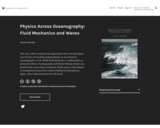
This class reflects material and approaches that were developed over 25 years of teaching undergraduates in the School of Oceanography at UW. While fluid mechanics is traditionally an advanced subject, Oceanography and Marine Biology majors can benefit from a more basic treatment, ideally early in their degree, as foundational material for understanding interdisciplinary topics. That is the motivation for this book.
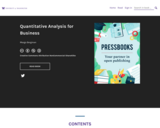
The objectives of this course are as follows: Demonstrate an understanding of graphical representations of data and their interpretation; Demonstrate a competency in mathematical tools of decision making, including derivatives and analytical optimization; Demonstrate an understanding of descriptive statistics, hypothesis testing, and the theory of regression; Demonstrate competency in the use of software used in quantitative analysis, including Excel tools and statistical software. This textbook is organized to support you in these goals. The textbook is adapted from Contemporary Calculus, written by Dale Hoffman from Bellevue Community College and Business Calculus written by Shana Calaway from Shoreline Community College. New material is written by Margo Bergman from University of Washington Tacoma.